Audit and Ethics Assignment on ANZ Banking Limited Company
VerifiedAdded on 2023/06/07
|13
|2194
|356
AI Summary
This assignment deals with making relevant assertions on the financial statements of ANZ Banking Limited Company. It includes materiality concern, preliminary analytical review, and review of the cash flow statement of the company.
Contribute Materials
Your contribution can guide someone’s learning journey. Share your
documents today.
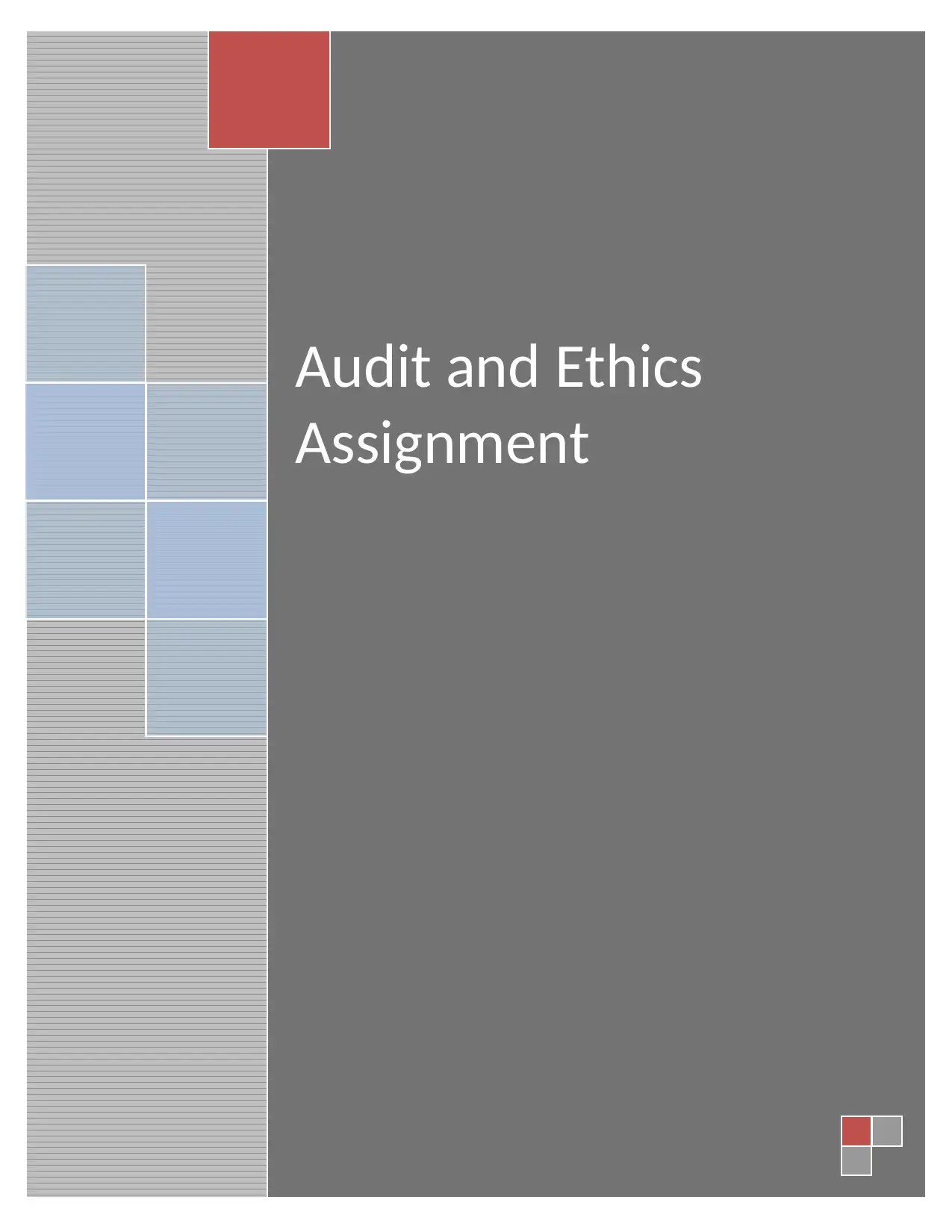
Audit and Ethics
Assignment
Assignment
Secure Best Marks with AI Grader
Need help grading? Try our AI Grader for instant feedback on your assignments.
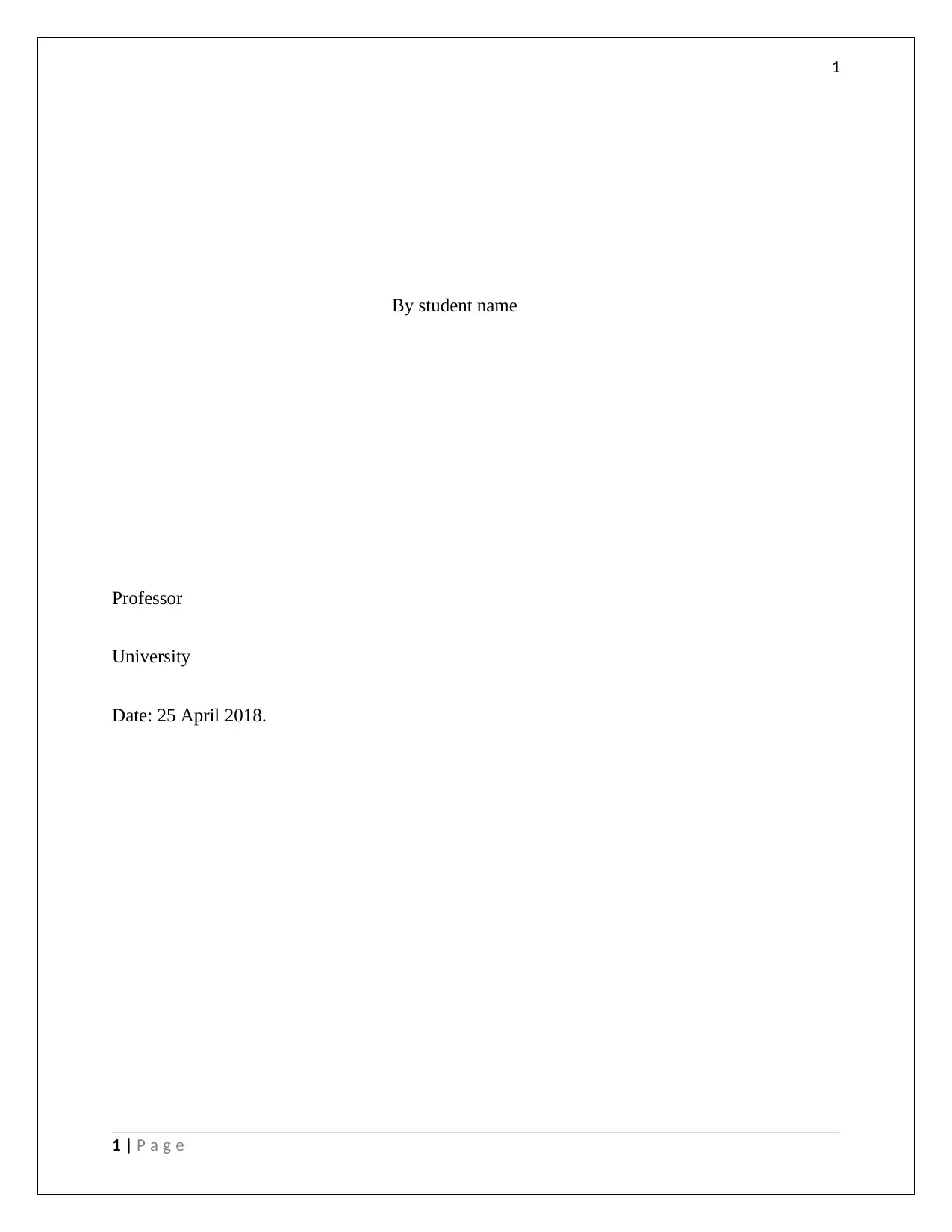
1
By student name
Professor
University
Date: 25 April 2018.
1 | P a g e
By student name
Professor
University
Date: 25 April 2018.
1 | P a g e
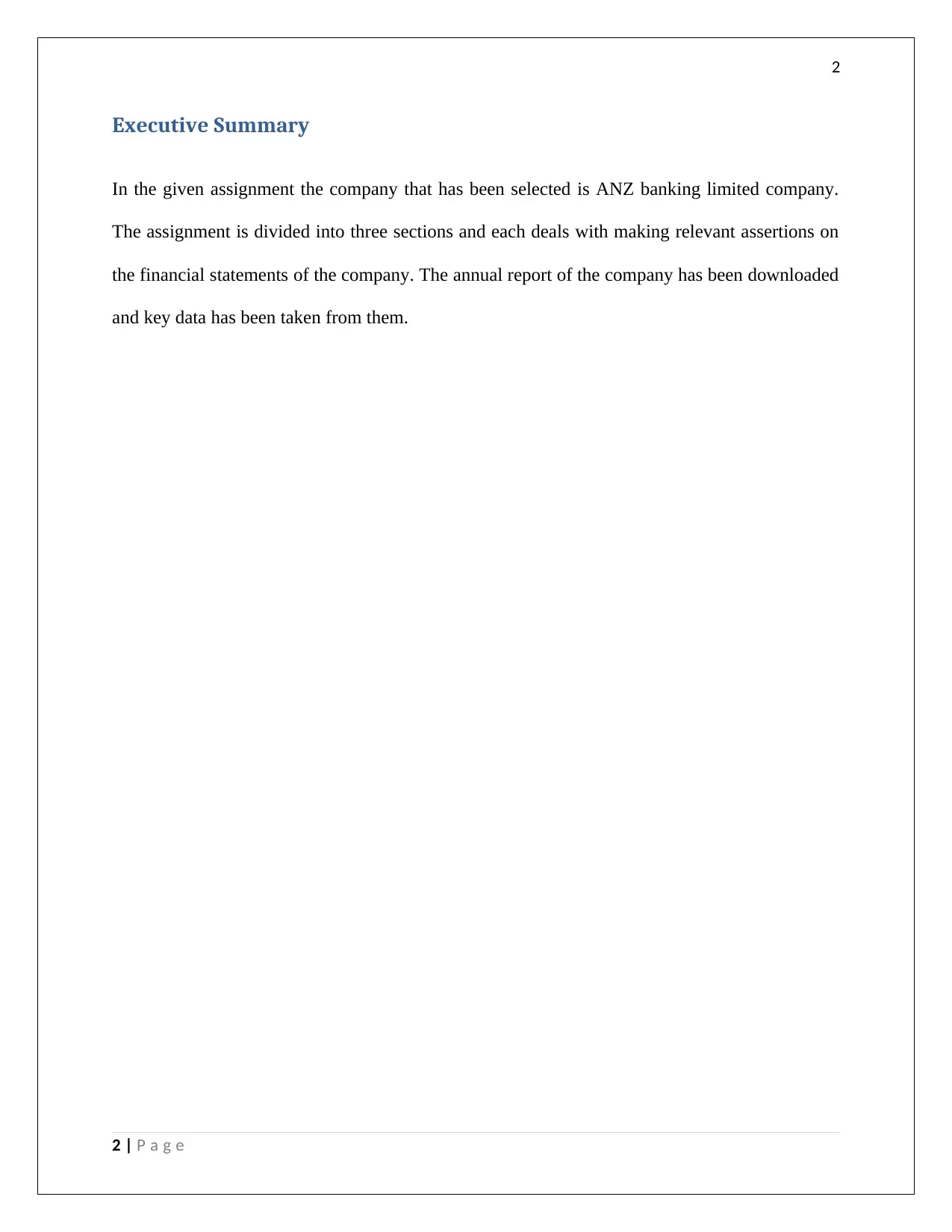
2
Executive Summary
In the given assignment the company that has been selected is ANZ banking limited company.
The assignment is divided into three sections and each deals with making relevant assertions on
the financial statements of the company. The annual report of the company has been downloaded
and key data has been taken from them.
2 | P a g e
Executive Summary
In the given assignment the company that has been selected is ANZ banking limited company.
The assignment is divided into three sections and each deals with making relevant assertions on
the financial statements of the company. The annual report of the company has been downloaded
and key data has been taken from them.
2 | P a g e
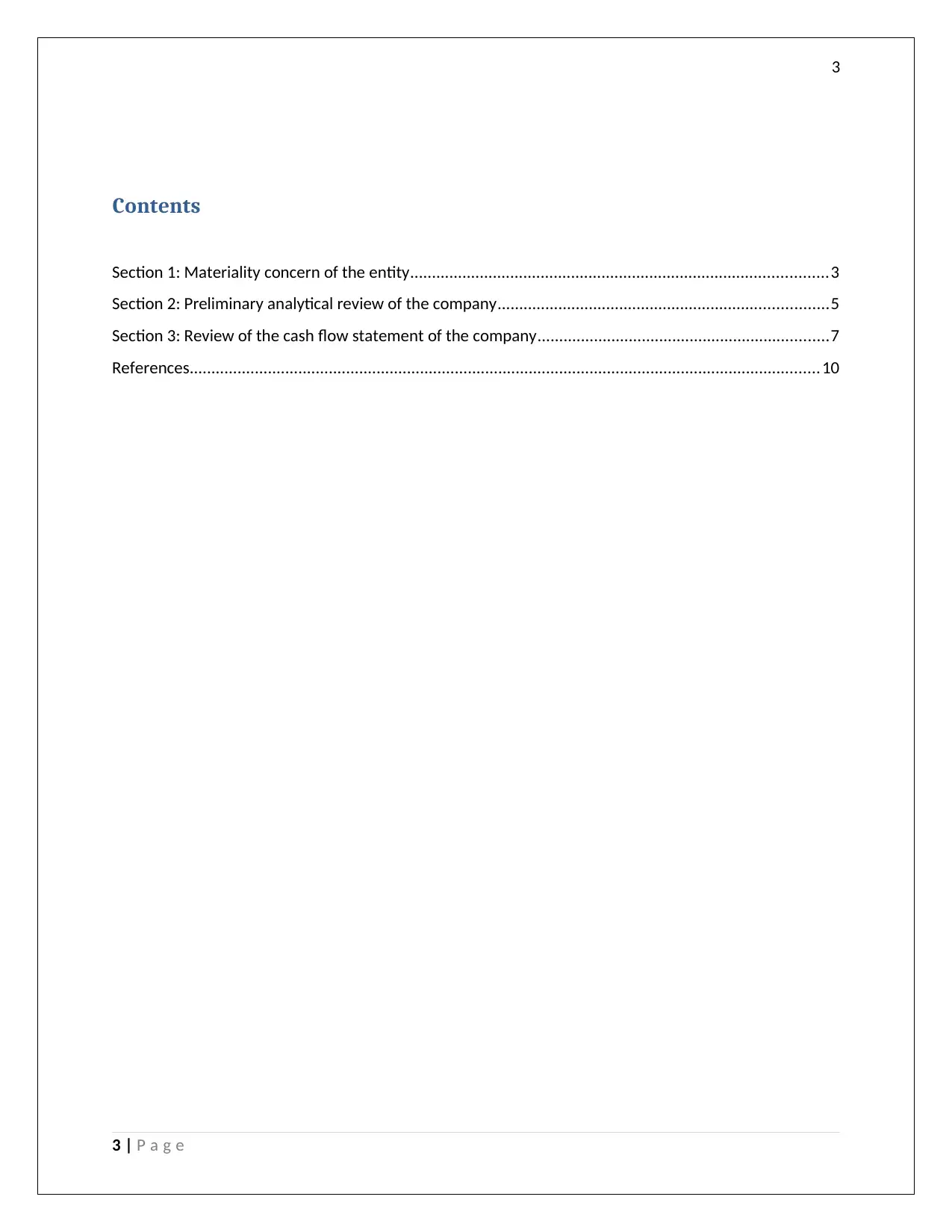
3
Contents
Section 1: Materiality concern of the entity................................................................................................3
Section 2: Preliminary analytical review of the company............................................................................5
Section 3: Review of the cash flow statement of the company...................................................................7
References.................................................................................................................................................10
3 | P a g e
Contents
Section 1: Materiality concern of the entity................................................................................................3
Section 2: Preliminary analytical review of the company............................................................................5
Section 3: Review of the cash flow statement of the company...................................................................7
References.................................................................................................................................................10
3 | P a g e
Secure Best Marks with AI Grader
Need help grading? Try our AI Grader for instant feedback on your assignments.
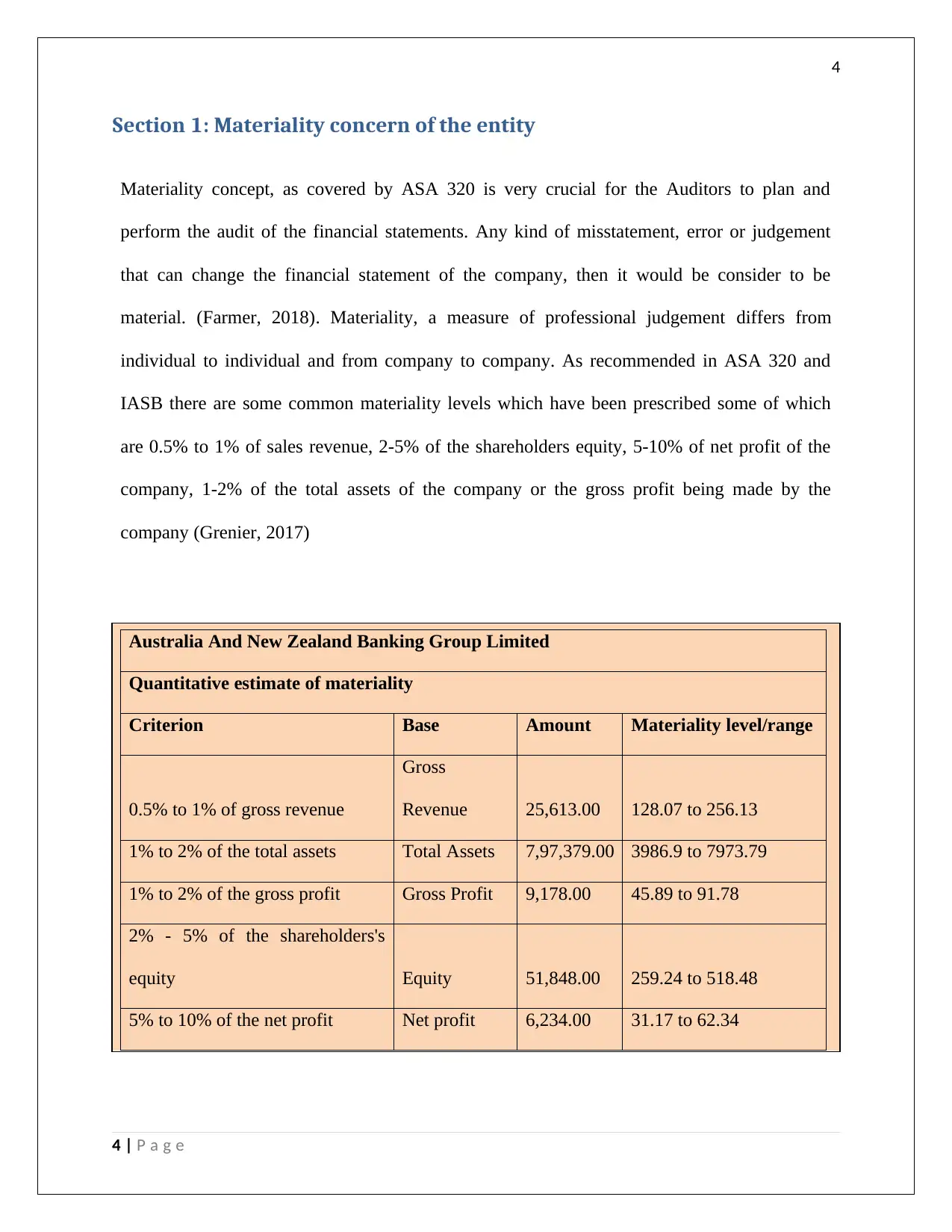
4
Section 1: Materiality concern of the entity
Materiality concept, as covered by ASA 320 is very crucial for the Auditors to plan and
perform the audit of the financial statements. Any kind of misstatement, error or judgement
that can change the financial statement of the company, then it would be consider to be
material. (Farmer, 2018). Materiality, a measure of professional judgement differs from
individual to individual and from company to company. As recommended in ASA 320 and
IASB there are some common materiality levels which have been prescribed some of which
are 0.5% to 1% of sales revenue, 2-5% of the shareholders equity, 5-10% of net profit of the
company, 1-2% of the total assets of the company or the gross profit being made by the
company (Grenier, 2017)
Australia And New Zealand Banking Group Limited
Quantitative estimate of materiality
Criterion Base Amount Materiality level/range
0.5% to 1% of gross revenue
Gross
Revenue 25,613.00 128.07 to 256.13
1% to 2% of the total assets Total Assets 7,97,379.00 3986.9 to 7973.79
1% to 2% of the gross profit Gross Profit 9,178.00 45.89 to 91.78
2% - 5% of the shareholders's
equity Equity 51,848.00 259.24 to 518.48
5% to 10% of the net profit Net profit 6,234.00 31.17 to 62.34
4 | P a g e
Section 1: Materiality concern of the entity
Materiality concept, as covered by ASA 320 is very crucial for the Auditors to plan and
perform the audit of the financial statements. Any kind of misstatement, error or judgement
that can change the financial statement of the company, then it would be consider to be
material. (Farmer, 2018). Materiality, a measure of professional judgement differs from
individual to individual and from company to company. As recommended in ASA 320 and
IASB there are some common materiality levels which have been prescribed some of which
are 0.5% to 1% of sales revenue, 2-5% of the shareholders equity, 5-10% of net profit of the
company, 1-2% of the total assets of the company or the gross profit being made by the
company (Grenier, 2017)
Australia And New Zealand Banking Group Limited
Quantitative estimate of materiality
Criterion Base Amount Materiality level/range
0.5% to 1% of gross revenue
Gross
Revenue 25,613.00 128.07 to 256.13
1% to 2% of the total assets Total Assets 7,97,379.00 3986.9 to 7973.79
1% to 2% of the gross profit Gross Profit 9,178.00 45.89 to 91.78
2% - 5% of the shareholders's
equity Equity 51,848.00 259.24 to 518.48
5% to 10% of the net profit Net profit 6,234.00 31.17 to 62.34
4 | P a g e
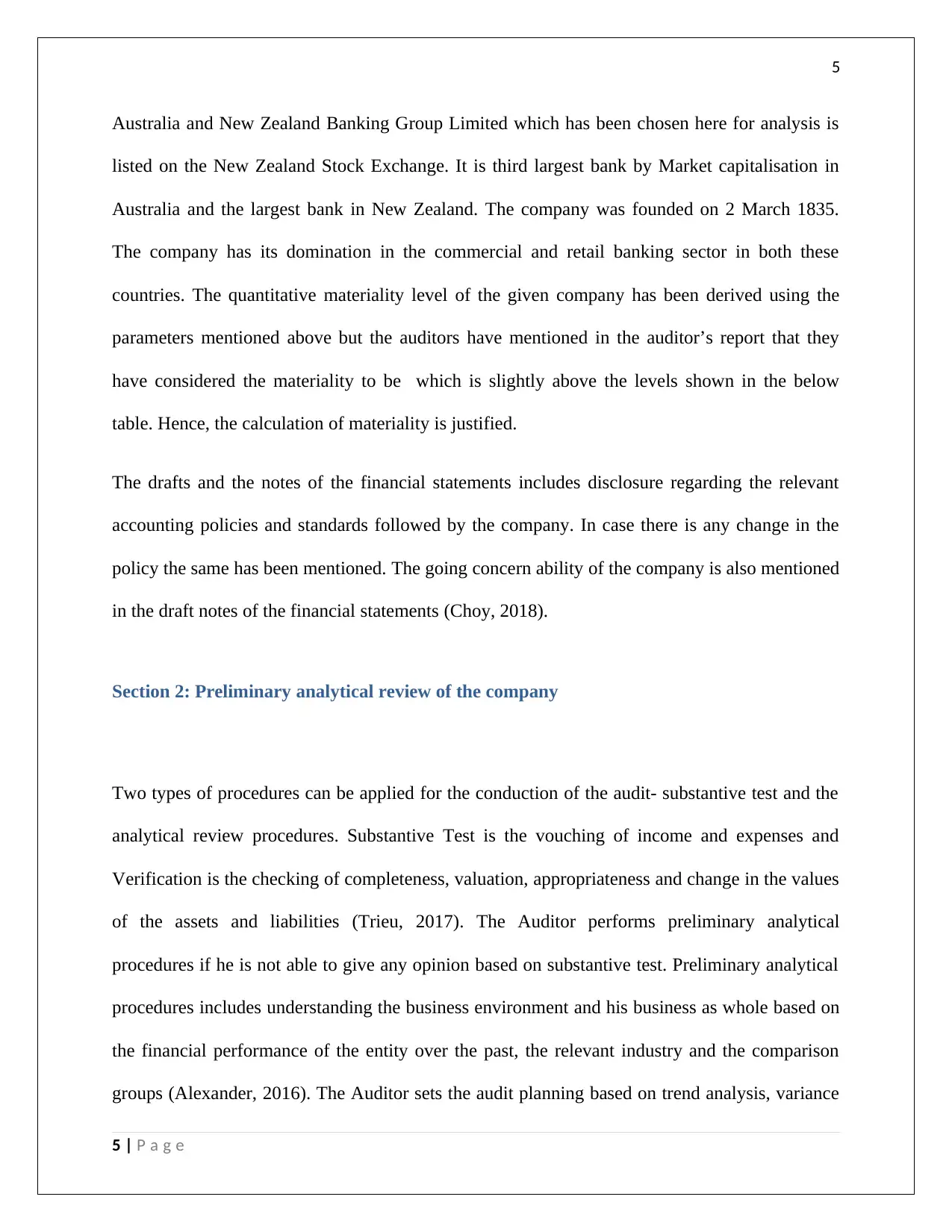
5
Australia and New Zealand Banking Group Limited which has been chosen here for analysis is
listed on the New Zealand Stock Exchange. It is third largest bank by Market capitalisation in
Australia and the largest bank in New Zealand. The company was founded on 2 March 1835.
The company has its domination in the commercial and retail banking sector in both these
countries. The quantitative materiality level of the given company has been derived using the
parameters mentioned above but the auditors have mentioned in the auditor’s report that they
have considered the materiality to be which is slightly above the levels shown in the below
table. Hence, the calculation of materiality is justified.
The drafts and the notes of the financial statements includes disclosure regarding the relevant
accounting policies and standards followed by the company. In case there is any change in the
policy the same has been mentioned. The going concern ability of the company is also mentioned
in the draft notes of the financial statements (Choy, 2018).
Section 2: Preliminary analytical review of the company
Two types of procedures can be applied for the conduction of the audit- substantive test and the
analytical review procedures. Substantive Test is the vouching of income and expenses and
Verification is the checking of completeness, valuation, appropriateness and change in the values
of the assets and liabilities (Trieu, 2017). The Auditor performs preliminary analytical
procedures if he is not able to give any opinion based on substantive test. Preliminary analytical
procedures includes understanding the business environment and his business as whole based on
the financial performance of the entity over the past, the relevant industry and the comparison
groups (Alexander, 2016). The Auditor sets the audit planning based on trend analysis, variance
5 | P a g e
Australia and New Zealand Banking Group Limited which has been chosen here for analysis is
listed on the New Zealand Stock Exchange. It is third largest bank by Market capitalisation in
Australia and the largest bank in New Zealand. The company was founded on 2 March 1835.
The company has its domination in the commercial and retail banking sector in both these
countries. The quantitative materiality level of the given company has been derived using the
parameters mentioned above but the auditors have mentioned in the auditor’s report that they
have considered the materiality to be which is slightly above the levels shown in the below
table. Hence, the calculation of materiality is justified.
The drafts and the notes of the financial statements includes disclosure regarding the relevant
accounting policies and standards followed by the company. In case there is any change in the
policy the same has been mentioned. The going concern ability of the company is also mentioned
in the draft notes of the financial statements (Choy, 2018).
Section 2: Preliminary analytical review of the company
Two types of procedures can be applied for the conduction of the audit- substantive test and the
analytical review procedures. Substantive Test is the vouching of income and expenses and
Verification is the checking of completeness, valuation, appropriateness and change in the values
of the assets and liabilities (Trieu, 2017). The Auditor performs preliminary analytical
procedures if he is not able to give any opinion based on substantive test. Preliminary analytical
procedures includes understanding the business environment and his business as whole based on
the financial performance of the entity over the past, the relevant industry and the comparison
groups (Alexander, 2016). The Auditor sets the audit planning based on trend analysis, variance
5 | P a g e
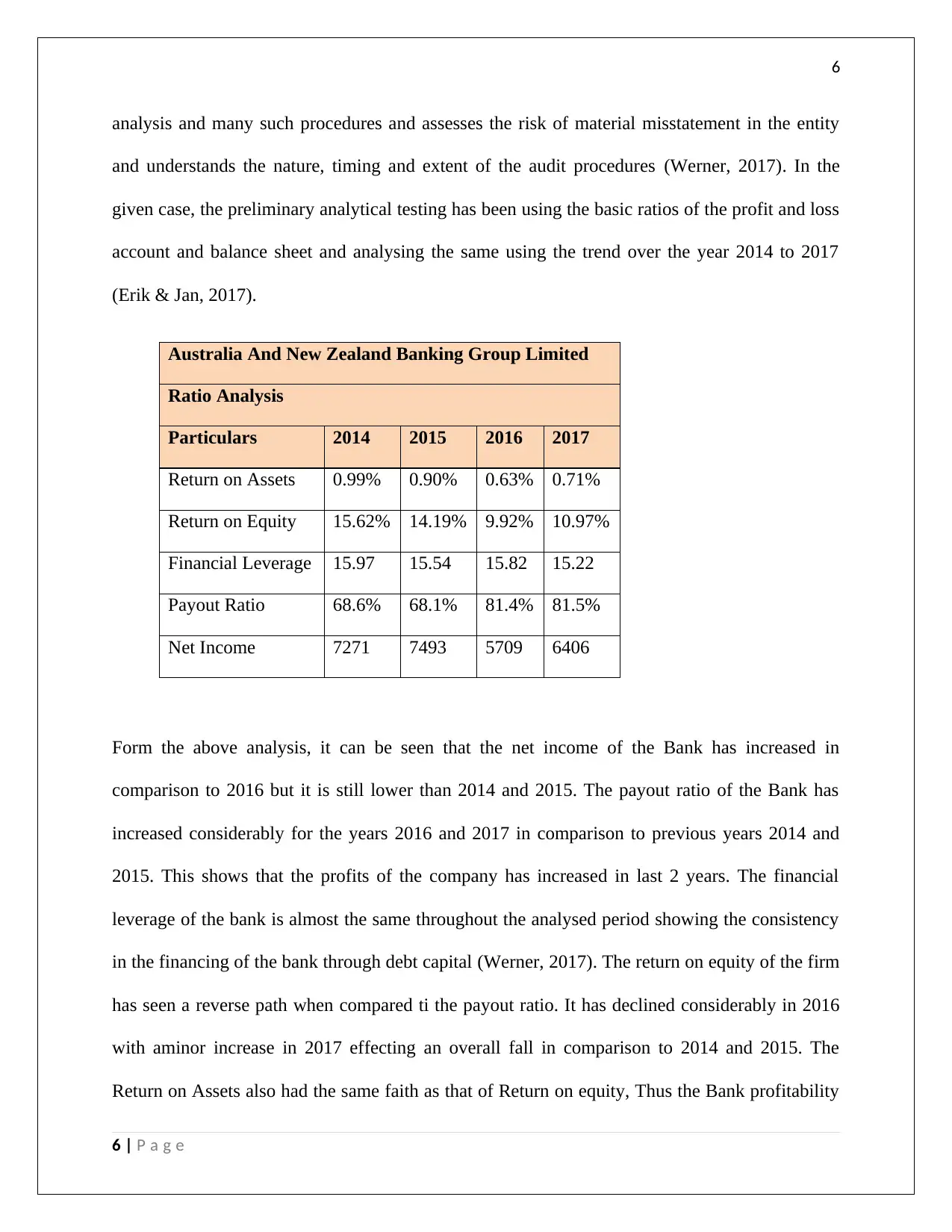
6
analysis and many such procedures and assesses the risk of material misstatement in the entity
and understands the nature, timing and extent of the audit procedures (Werner, 2017). In the
given case, the preliminary analytical testing has been using the basic ratios of the profit and loss
account and balance sheet and analysing the same using the trend over the year 2014 to 2017
(Erik & Jan, 2017).
Australia And New Zealand Banking Group Limited
Ratio Analysis
Particulars 2014 2015 2016 2017
Return on Assets 0.99% 0.90% 0.63% 0.71%
Return on Equity 15.62% 14.19% 9.92% 10.97%
Financial Leverage 15.97 15.54 15.82 15.22
Payout Ratio 68.6% 68.1% 81.4% 81.5%
Net Income 7271 7493 5709 6406
Form the above analysis, it can be seen that the net income of the Bank has increased in
comparison to 2016 but it is still lower than 2014 and 2015. The payout ratio of the Bank has
increased considerably for the years 2016 and 2017 in comparison to previous years 2014 and
2015. This shows that the profits of the company has increased in last 2 years. The financial
leverage of the bank is almost the same throughout the analysed period showing the consistency
in the financing of the bank through debt capital (Werner, 2017). The return on equity of the firm
has seen a reverse path when compared ti the payout ratio. It has declined considerably in 2016
with aminor increase in 2017 effecting an overall fall in comparison to 2014 and 2015. The
Return on Assets also had the same faith as that of Return on equity, Thus the Bank profitability
6 | P a g e
analysis and many such procedures and assesses the risk of material misstatement in the entity
and understands the nature, timing and extent of the audit procedures (Werner, 2017). In the
given case, the preliminary analytical testing has been using the basic ratios of the profit and loss
account and balance sheet and analysing the same using the trend over the year 2014 to 2017
(Erik & Jan, 2017).
Australia And New Zealand Banking Group Limited
Ratio Analysis
Particulars 2014 2015 2016 2017
Return on Assets 0.99% 0.90% 0.63% 0.71%
Return on Equity 15.62% 14.19% 9.92% 10.97%
Financial Leverage 15.97 15.54 15.82 15.22
Payout Ratio 68.6% 68.1% 81.4% 81.5%
Net Income 7271 7493 5709 6406
Form the above analysis, it can be seen that the net income of the Bank has increased in
comparison to 2016 but it is still lower than 2014 and 2015. The payout ratio of the Bank has
increased considerably for the years 2016 and 2017 in comparison to previous years 2014 and
2015. This shows that the profits of the company has increased in last 2 years. The financial
leverage of the bank is almost the same throughout the analysed period showing the consistency
in the financing of the bank through debt capital (Werner, 2017). The return on equity of the firm
has seen a reverse path when compared ti the payout ratio. It has declined considerably in 2016
with aminor increase in 2017 effecting an overall fall in comparison to 2014 and 2015. The
Return on Assets also had the same faith as that of Return on equity, Thus the Bank profitability
6 | P a g e
Paraphrase This Document
Need a fresh take? Get an instant paraphrase of this document with our AI Paraphraser
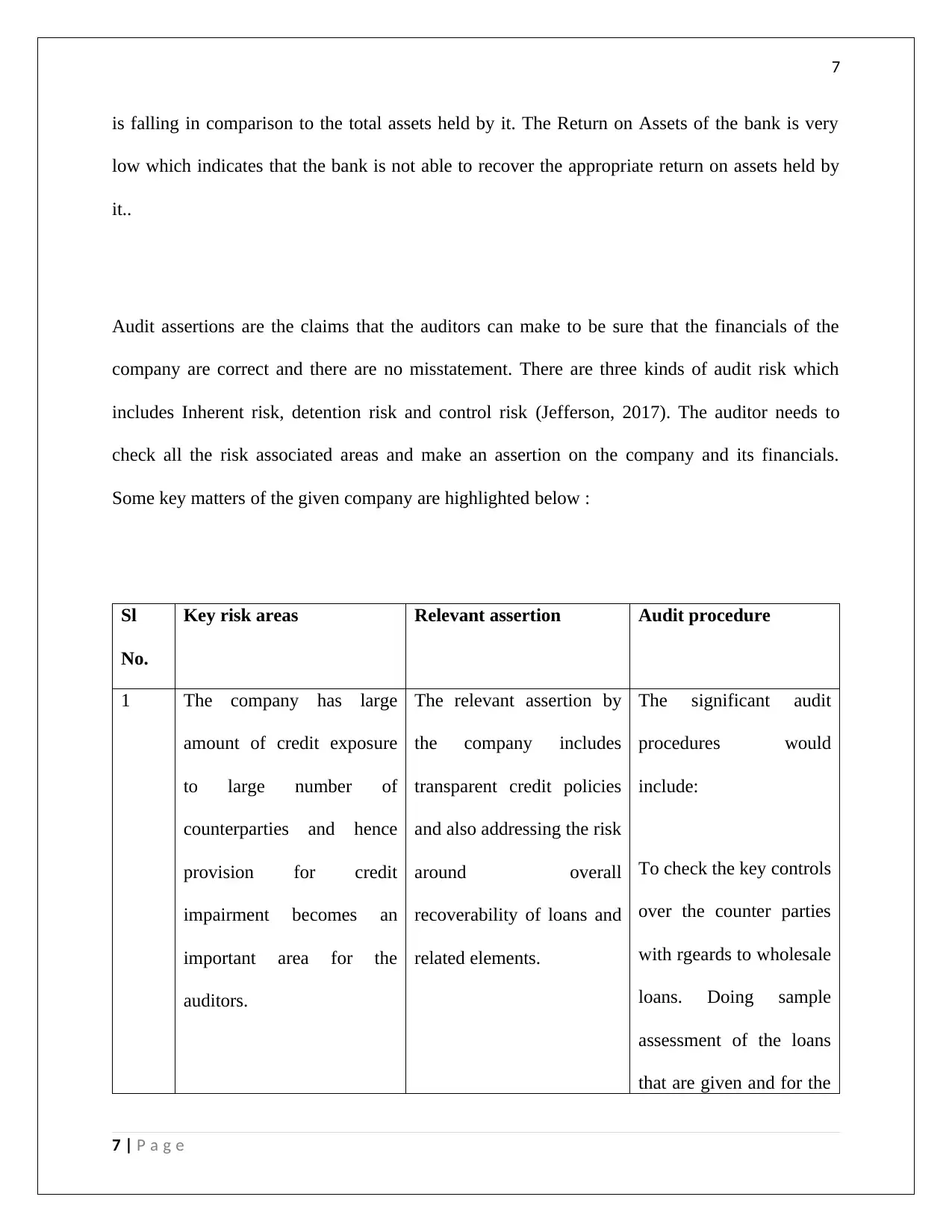
7
is falling in comparison to the total assets held by it. The Return on Assets of the bank is very
low which indicates that the bank is not able to recover the appropriate return on assets held by
it..
Audit assertions are the claims that the auditors can make to be sure that the financials of the
company are correct and there are no misstatement. There are three kinds of audit risk which
includes Inherent risk, detention risk and control risk (Jefferson, 2017). The auditor needs to
check all the risk associated areas and make an assertion on the company and its financials.
Some key matters of the given company are highlighted below :
Sl
No.
Key risk areas Relevant assertion Audit procedure
1 The company has large
amount of credit exposure
to large number of
counterparties and hence
provision for credit
impairment becomes an
important area for the
auditors.
The relevant assertion by
the company includes
transparent credit policies
and also addressing the risk
around overall
recoverability of loans and
related elements.
The significant audit
procedures would
include:
To check the key controls
over the counter parties
with rgeards to wholesale
loans. Doing sample
assessment of the loans
that are given and for the
7 | P a g e
is falling in comparison to the total assets held by it. The Return on Assets of the bank is very
low which indicates that the bank is not able to recover the appropriate return on assets held by
it..
Audit assertions are the claims that the auditors can make to be sure that the financials of the
company are correct and there are no misstatement. There are three kinds of audit risk which
includes Inherent risk, detention risk and control risk (Jefferson, 2017). The auditor needs to
check all the risk associated areas and make an assertion on the company and its financials.
Some key matters of the given company are highlighted below :
Sl
No.
Key risk areas Relevant assertion Audit procedure
1 The company has large
amount of credit exposure
to large number of
counterparties and hence
provision for credit
impairment becomes an
important area for the
auditors.
The relevant assertion by
the company includes
transparent credit policies
and also addressing the risk
around overall
recoverability of loans and
related elements.
The significant audit
procedures would
include:
To check the key controls
over the counter parties
with rgeards to wholesale
loans. Doing sample
assessment of the loans
that are given and for the
7 | P a g e
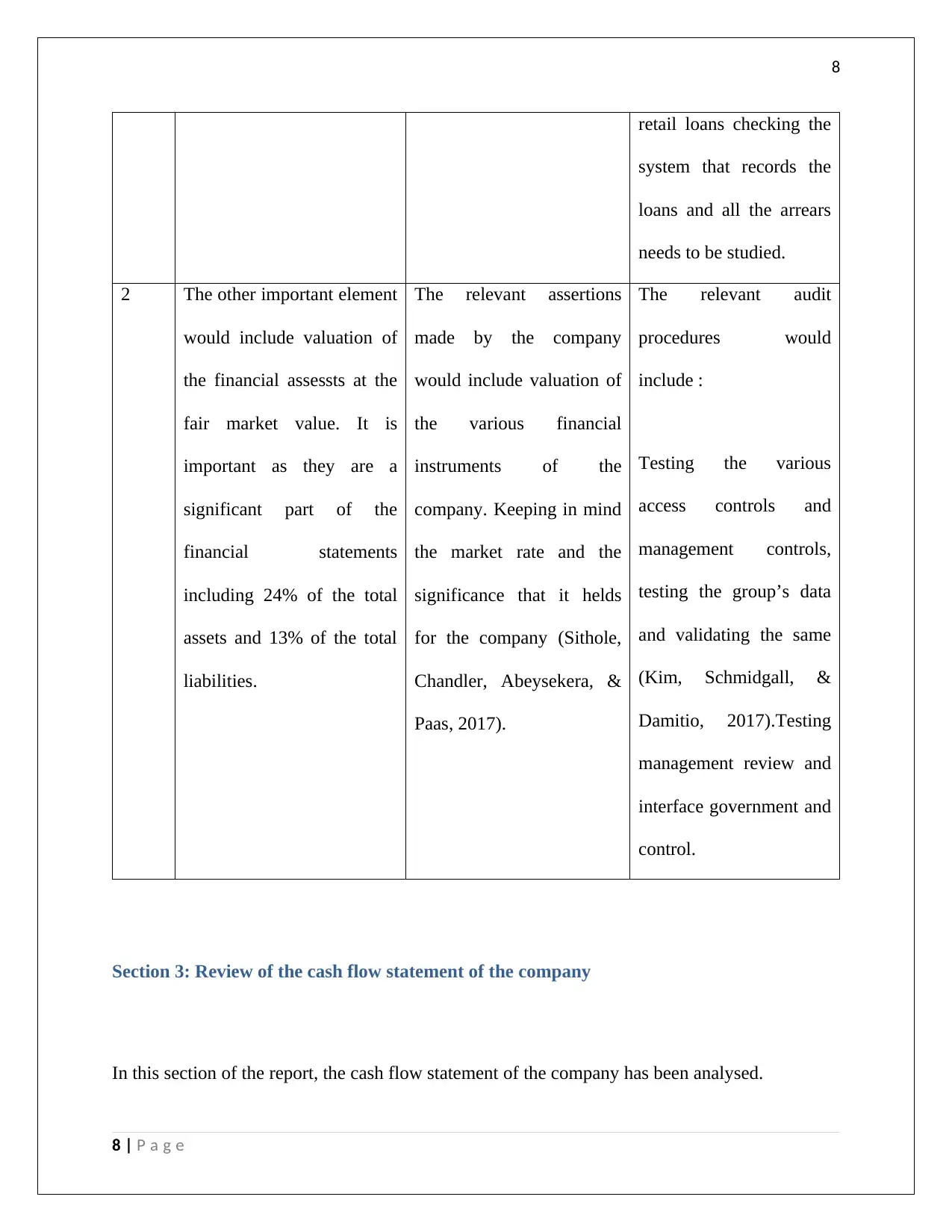
8
retail loans checking the
system that records the
loans and all the arrears
needs to be studied.
2 The other important element
would include valuation of
the financial assessts at the
fair market value. It is
important as they are a
significant part of the
financial statements
including 24% of the total
assets and 13% of the total
liabilities.
The relevant assertions
made by the company
would include valuation of
the various financial
instruments of the
company. Keeping in mind
the market rate and the
significance that it helds
for the company (Sithole,
Chandler, Abeysekera, &
Paas, 2017).
The relevant audit
procedures would
include :
Testing the various
access controls and
management controls,
testing the group’s data
and validating the same
(Kim, Schmidgall, &
Damitio, 2017).Testing
management review and
interface government and
control.
Section 3: Review of the cash flow statement of the company
In this section of the report, the cash flow statement of the company has been analysed.
8 | P a g e
retail loans checking the
system that records the
loans and all the arrears
needs to be studied.
2 The other important element
would include valuation of
the financial assessts at the
fair market value. It is
important as they are a
significant part of the
financial statements
including 24% of the total
assets and 13% of the total
liabilities.
The relevant assertions
made by the company
would include valuation of
the various financial
instruments of the
company. Keeping in mind
the market rate and the
significance that it helds
for the company (Sithole,
Chandler, Abeysekera, &
Paas, 2017).
The relevant audit
procedures would
include :
Testing the various
access controls and
management controls,
testing the group’s data
and validating the same
(Kim, Schmidgall, &
Damitio, 2017).Testing
management review and
interface government and
control.
Section 3: Review of the cash flow statement of the company
In this section of the report, the cash flow statement of the company has been analysed.
8 | P a g e
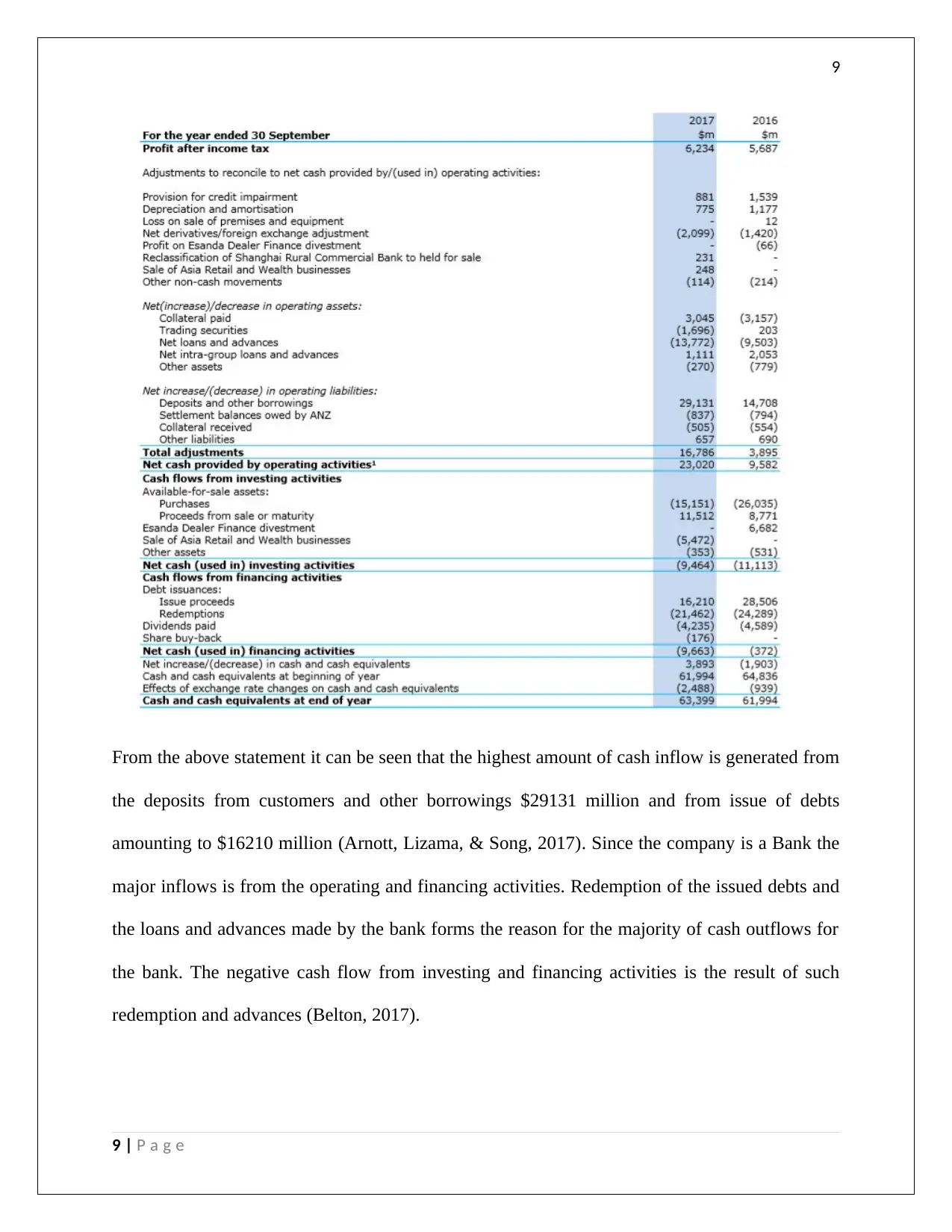
9
From the above statement it can be seen that the highest amount of cash inflow is generated from
the deposits from customers and other borrowings $29131 million and from issue of debts
amounting to $16210 million (Arnott, Lizama, & Song, 2017). Since the company is a Bank the
major inflows is from the operating and financing activities. Redemption of the issued debts and
the loans and advances made by the bank forms the reason for the majority of cash outflows for
the bank. The negative cash flow from investing and financing activities is the result of such
redemption and advances (Belton, 2017).
9 | P a g e
From the above statement it can be seen that the highest amount of cash inflow is generated from
the deposits from customers and other borrowings $29131 million and from issue of debts
amounting to $16210 million (Arnott, Lizama, & Song, 2017). Since the company is a Bank the
major inflows is from the operating and financing activities. Redemption of the issued debts and
the loans and advances made by the bank forms the reason for the majority of cash outflows for
the bank. The negative cash flow from investing and financing activities is the result of such
redemption and advances (Belton, 2017).
9 | P a g e
Secure Best Marks with AI Grader
Need help grading? Try our AI Grader for instant feedback on your assignments.
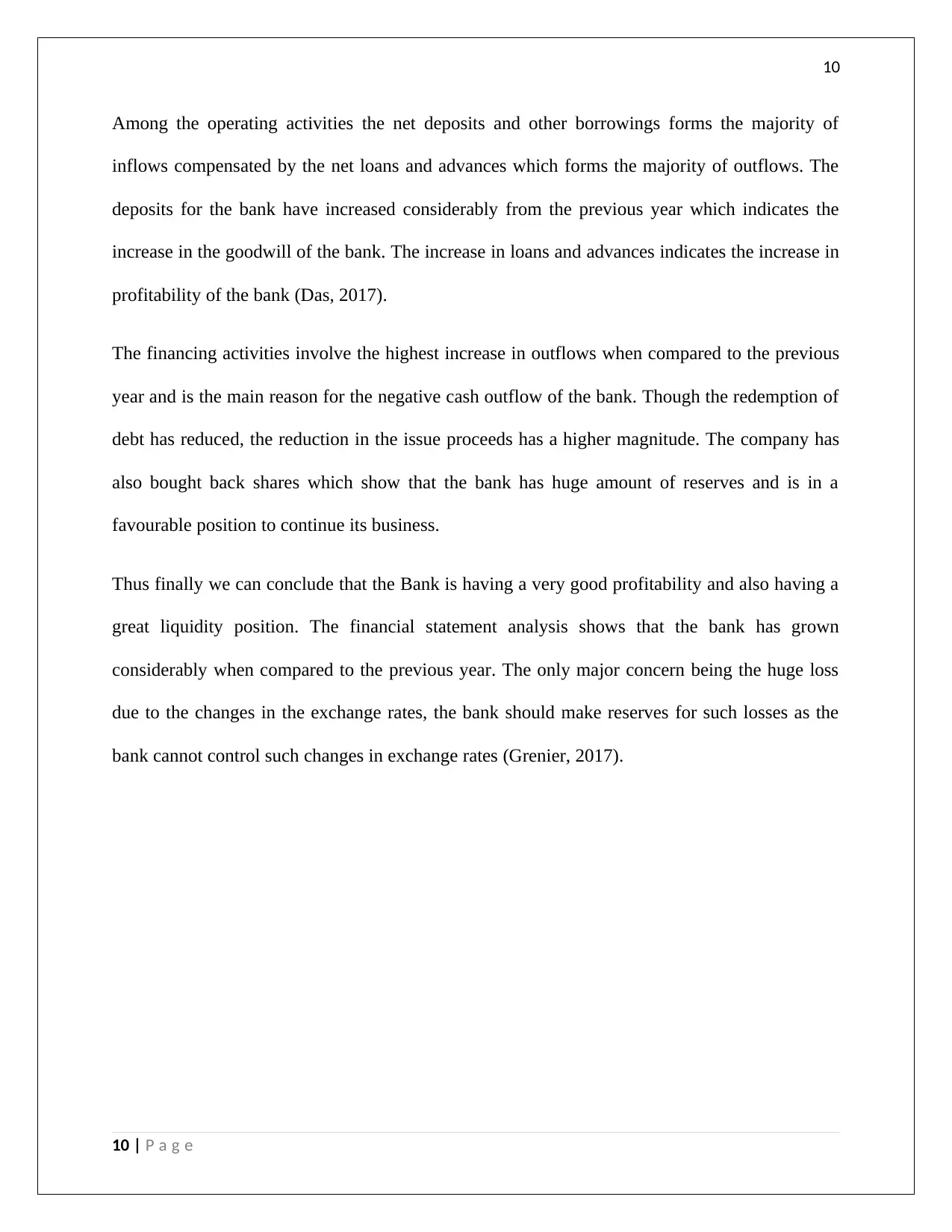
10
Among the operating activities the net deposits and other borrowings forms the majority of
inflows compensated by the net loans and advances which forms the majority of outflows. The
deposits for the bank have increased considerably from the previous year which indicates the
increase in the goodwill of the bank. The increase in loans and advances indicates the increase in
profitability of the bank (Das, 2017).
The financing activities involve the highest increase in outflows when compared to the previous
year and is the main reason for the negative cash outflow of the bank. Though the redemption of
debt has reduced, the reduction in the issue proceeds has a higher magnitude. The company has
also bought back shares which show that the bank has huge amount of reserves and is in a
favourable position to continue its business.
Thus finally we can conclude that the Bank is having a very good profitability and also having a
great liquidity position. The financial statement analysis shows that the bank has grown
considerably when compared to the previous year. The only major concern being the huge loss
due to the changes in the exchange rates, the bank should make reserves for such losses as the
bank cannot control such changes in exchange rates (Grenier, 2017).
10 | P a g e
Among the operating activities the net deposits and other borrowings forms the majority of
inflows compensated by the net loans and advances which forms the majority of outflows. The
deposits for the bank have increased considerably from the previous year which indicates the
increase in the goodwill of the bank. The increase in loans and advances indicates the increase in
profitability of the bank (Das, 2017).
The financing activities involve the highest increase in outflows when compared to the previous
year and is the main reason for the negative cash outflow of the bank. Though the redemption of
debt has reduced, the reduction in the issue proceeds has a higher magnitude. The company has
also bought back shares which show that the bank has huge amount of reserves and is in a
favourable position to continue its business.
Thus finally we can conclude that the Bank is having a very good profitability and also having a
great liquidity position. The financial statement analysis shows that the bank has grown
considerably when compared to the previous year. The only major concern being the huge loss
due to the changes in the exchange rates, the bank should make reserves for such losses as the
bank cannot control such changes in exchange rates (Grenier, 2017).
10 | P a g e
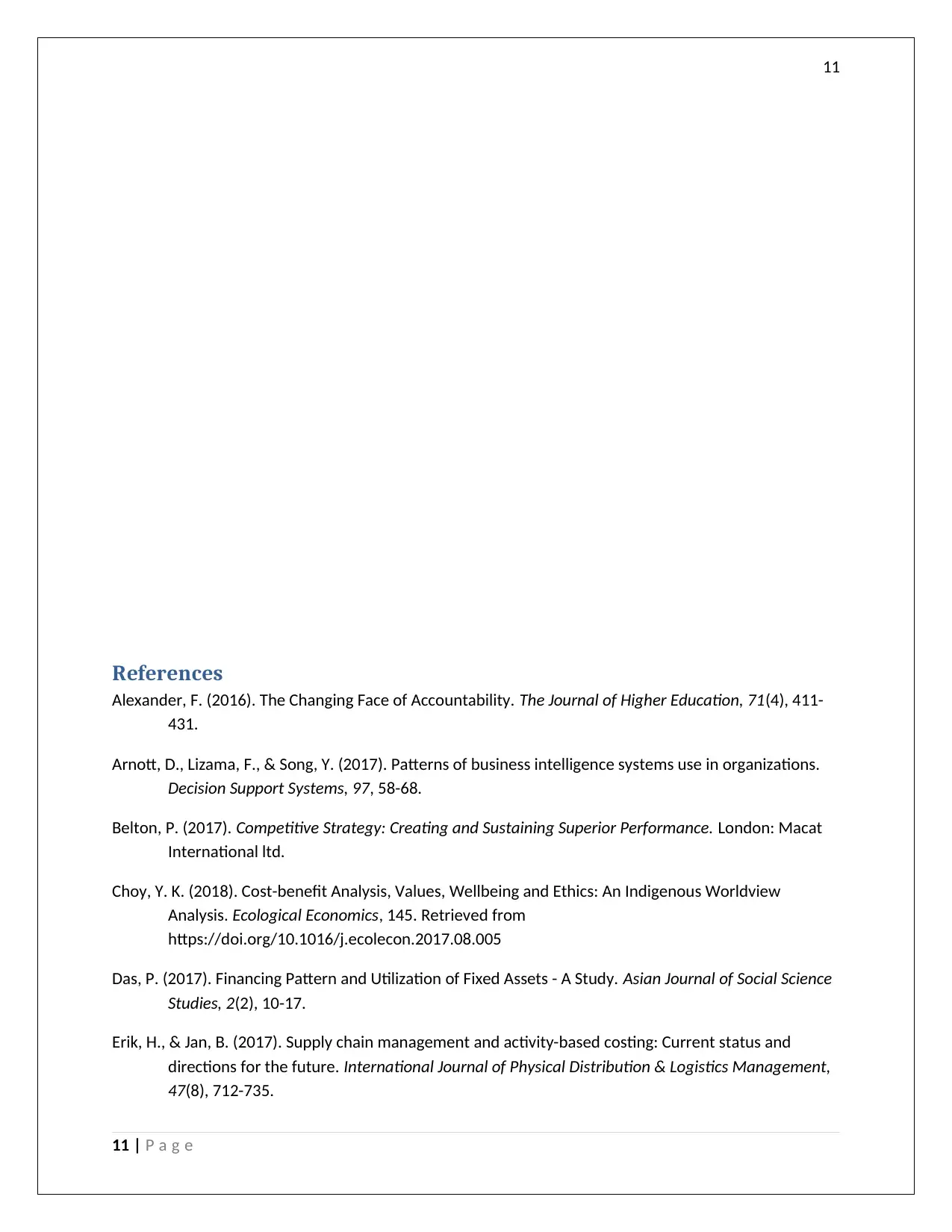
11
References
Alexander, F. (2016). The Changing Face of Accountability. The Journal of Higher Education, 71(4), 411-
431.
Arnott, D., Lizama, F., & Song, Y. (2017). Patterns of business intelligence systems use in organizations.
Decision Support Systems, 97, 58-68.
Belton, P. (2017). Competitive Strategy: Creating and Sustaining Superior Performance. London: Macat
International ltd.
Choy, Y. K. (2018). Cost-benefit Analysis, Values, Wellbeing and Ethics: An Indigenous Worldview
Analysis. Ecological Economics, 145. Retrieved from
https://doi.org/10.1016/j.ecolecon.2017.08.005
Das, P. (2017). Financing Pattern and Utilization of Fixed Assets - A Study. Asian Journal of Social Science
Studies, 2(2), 10-17.
Erik, H., & Jan, B. (2017). Supply chain management and activity-based costing: Current status and
directions for the future. International Journal of Physical Distribution & Logistics Management,
47(8), 712-735.
11 | P a g e
References
Alexander, F. (2016). The Changing Face of Accountability. The Journal of Higher Education, 71(4), 411-
431.
Arnott, D., Lizama, F., & Song, Y. (2017). Patterns of business intelligence systems use in organizations.
Decision Support Systems, 97, 58-68.
Belton, P. (2017). Competitive Strategy: Creating and Sustaining Superior Performance. London: Macat
International ltd.
Choy, Y. K. (2018). Cost-benefit Analysis, Values, Wellbeing and Ethics: An Indigenous Worldview
Analysis. Ecological Economics, 145. Retrieved from
https://doi.org/10.1016/j.ecolecon.2017.08.005
Das, P. (2017). Financing Pattern and Utilization of Fixed Assets - A Study. Asian Journal of Social Science
Studies, 2(2), 10-17.
Erik, H., & Jan, B. (2017). Supply chain management and activity-based costing: Current status and
directions for the future. International Journal of Physical Distribution & Logistics Management,
47(8), 712-735.
11 | P a g e
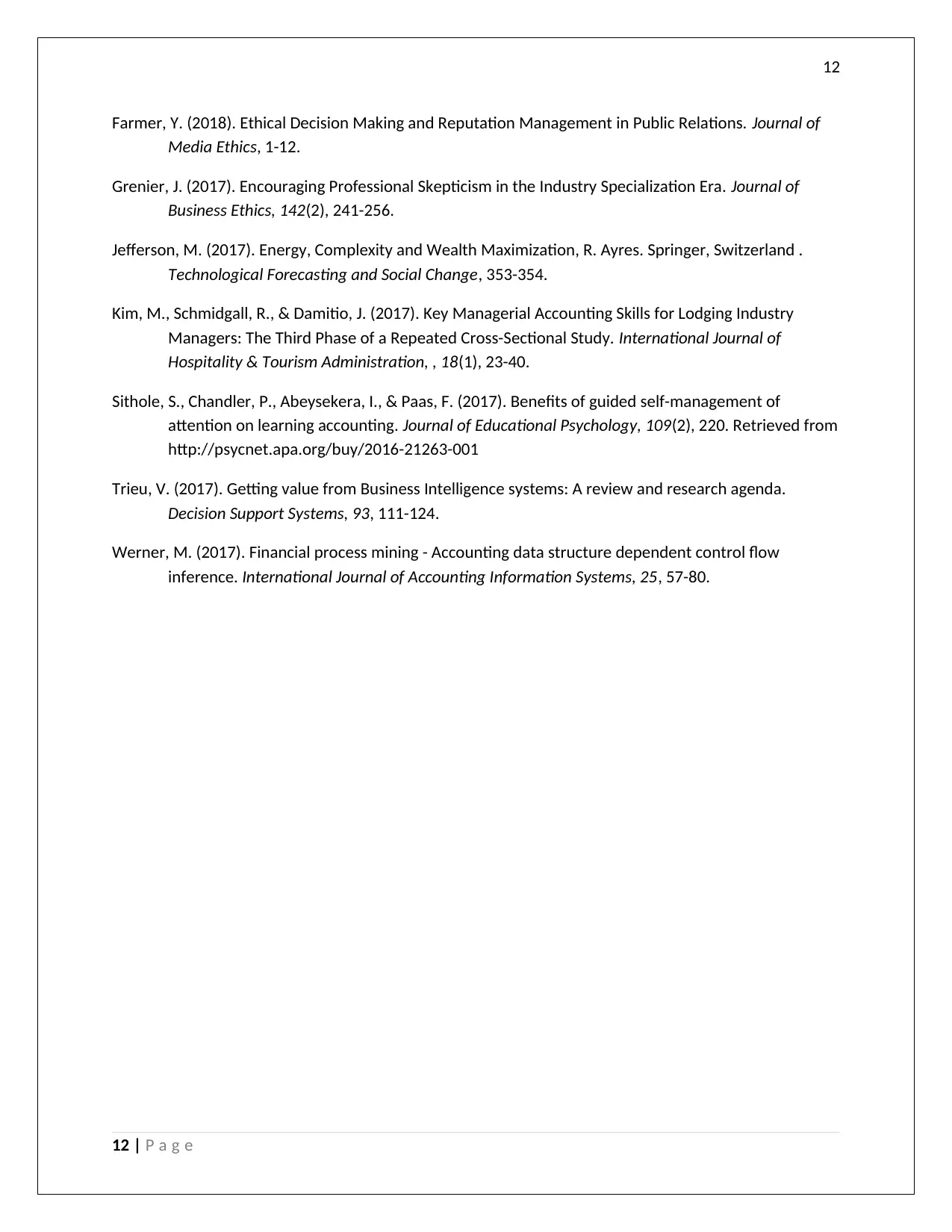
12
Farmer, Y. (2018). Ethical Decision Making and Reputation Management in Public Relations. Journal of
Media Ethics, 1-12.
Grenier, J. (2017). Encouraging Professional Skepticism in the Industry Specialization Era. Journal of
Business Ethics, 142(2), 241-256.
Jefferson, M. (2017). Energy, Complexity and Wealth Maximization, R. Ayres. Springer, Switzerland .
Technological Forecasting and Social Change, 353-354.
Kim, M., Schmidgall, R., & Damitio, J. (2017). Key Managerial Accounting Skills for Lodging Industry
Managers: The Third Phase of a Repeated Cross-Sectional Study. International Journal of
Hospitality & Tourism Administration, , 18(1), 23-40.
Sithole, S., Chandler, P., Abeysekera, I., & Paas, F. (2017). Benefits of guided self-management of
attention on learning accounting. Journal of Educational Psychology, 109(2), 220. Retrieved from
http://psycnet.apa.org/buy/2016-21263-001
Trieu, V. (2017). Getting value from Business Intelligence systems: A review and research agenda.
Decision Support Systems, 93, 111-124.
Werner, M. (2017). Financial process mining - Accounting data structure dependent control flow
inference. International Journal of Accounting Information Systems, 25, 57-80.
12 | P a g e
Farmer, Y. (2018). Ethical Decision Making and Reputation Management in Public Relations. Journal of
Media Ethics, 1-12.
Grenier, J. (2017). Encouraging Professional Skepticism in the Industry Specialization Era. Journal of
Business Ethics, 142(2), 241-256.
Jefferson, M. (2017). Energy, Complexity and Wealth Maximization, R. Ayres. Springer, Switzerland .
Technological Forecasting and Social Change, 353-354.
Kim, M., Schmidgall, R., & Damitio, J. (2017). Key Managerial Accounting Skills for Lodging Industry
Managers: The Third Phase of a Repeated Cross-Sectional Study. International Journal of
Hospitality & Tourism Administration, , 18(1), 23-40.
Sithole, S., Chandler, P., Abeysekera, I., & Paas, F. (2017). Benefits of guided self-management of
attention on learning accounting. Journal of Educational Psychology, 109(2), 220. Retrieved from
http://psycnet.apa.org/buy/2016-21263-001
Trieu, V. (2017). Getting value from Business Intelligence systems: A review and research agenda.
Decision Support Systems, 93, 111-124.
Werner, M. (2017). Financial process mining - Accounting data structure dependent control flow
inference. International Journal of Accounting Information Systems, 25, 57-80.
12 | P a g e
1 out of 13
Related Documents
Your All-in-One AI-Powered Toolkit for Academic Success.
+13062052269
info@desklib.com
Available 24*7 on WhatsApp / Email
![[object Object]](/_next/static/media/star-bottom.7253800d.svg)
Unlock your academic potential
© 2024 | Zucol Services PVT LTD | All rights reserved.





